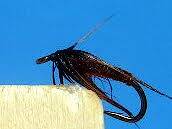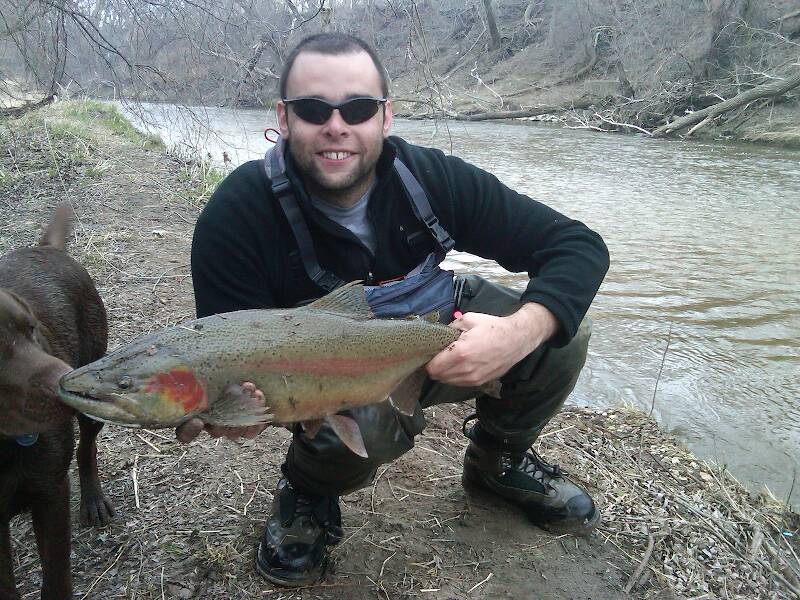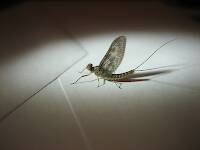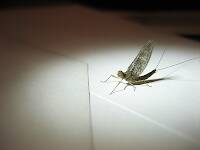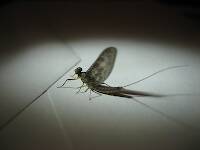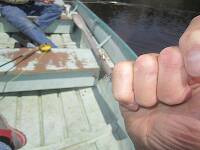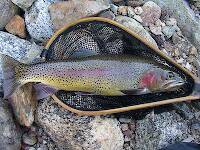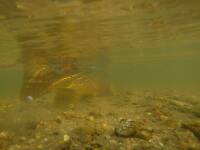
Blue-winged Olives
Baetis
Tiny Baetis mayflies are perhaps the most commonly encountered and imitated by anglers on all American trout streams due to their great abundance, widespread distribution, and trout-friendly emergence habits.
Featured on the forum

This is an interesting one. Following the keys in Merritt R.W., Cummins, K.W., and Berg, M.B. (2019) and Jacobus et al. (2014), it keys clearly to Ephemerella. Jacobus et al provide a key to species, but some of the characteristics are tricky to interpret without illustrations. If I didn't make any mistakes, this one keys to Ephemerella mucronata, which has not previously been reported any closer to here than Montana and Alberta. The main character seems to fit well: "Abdominal terga with prominent, paired, subparallel, spiculate ridges." Several illustrations or descriptions of this holarctic species from the US and Europe seem to match, including the body length, tarsal claws and denticles, labial palp, and gill shapes. These sources include including Richard Allen's original description of this species in North America under the now-defunct name E. moffatae in Allen RK (1977) and the figures in this description of the species in Italy.

Troutnut is a project started in 2003 by salmonid ecologist Jason "Troutnut" Neuswanger to help anglers and
fly tyers unabashedly embrace the entomological side of the sport. Learn more about Troutnut or
support the project for an enhanced experience here.
WestCO on Oct 6, 2012October 6th, 2012, 6:14 pm EDT
I took this picture as a joke to send to my friend who is always bugging me with his monster trout, and then we got into a debate over what kind of a trout it is. He thinks its a tiger and I think its some kind of hybrid brown/char. I definitely don't think its a tiger, my explanation was that the Frying Pan has so many generations of fish that almost everything is a hybrid of something. I just can't peg these markings. Thanks!


...but fishermen I have noticed, they don't care if I'm rich or poor, wearing robes or waders, all they care about is the fish, the river, and the game we play. For fishermen, the only virtues are patience, tolerance, and humility. I like this.
Sayfu
Posts: 560
Posts: 560
Sayfu on Oct 6, 2012October 6th, 2012, 6:51 pm EDT
That is the rare, and elusive Snail Darter
WestCO on Oct 6, 2012October 6th, 2012, 8:35 pm EDT
Haha.
...but fishermen I have noticed, they don't care if I'm rich or poor, wearing robes or waders, all they care about is the fish, the river, and the game we play. For fishermen, the only virtues are patience, tolerance, and humility. I like this.
Entoman on Oct 6, 2012October 6th, 2012, 8:54 pm EDT
The sparse spotting on the back towards the head, pink cast to the gill plate and lack of throat slash makes me think cutbow - without much cutthroat (they usually exhibit at least some slash).
"It's not that I find fishing so important, it's just that I find all other endeavors of Man equally unimportant... And not nearly as much fun!" Robert Traver, Anatomy of a Fisherman
PaulRoberts on Oct 7, 2012October 7th, 2012, 6:17 am EDT
I think it's a brown parr. Dark in color from being in shadow/under cover/ against dark bottom. Fin colors, and dark spot behind eye.
DUBBN on Oct 7, 2012October 7th, 2012, 7:41 am EDT
Looks like a Blue mark behind the eye, but I cant be sure. Pretty sure it's a juvenile Brown though.
It's OK to disagree with me. I can not force you to be right.
Kschaefer3 on Oct 7, 2012October 7th, 2012, 11:49 am EDT
I have to agree with DUBBN. Looks like a lot of smaller browns I've caught out of rivers on the north shore of Minnesota and Wisconsin. Interesting (to me anyway), that juvenile browns out of spring creeks seem to hold a more "traditional" coloration. When I first started I used to confuse these juvenile browns with brookies because of the darker blue/green coloration on the back.
Entoman on Oct 7, 2012October 7th, 2012, 12:56 pm EDT
Sorry for misleading you Westco, as the guys are right. After a closer look, I can see a few tiny red spots with many of them haloed towards the tail. Also, the fins should be more rosy on a cutbow and less amber as Paul mentioned. I don't think there's any char in this little guy as it lacks pale vermiculations (squigglies) and pale spotting on a dark background. Paul also makes a good point that different environments can influence coloration quite dramatically. The hasty glance noticing the pink field on the gill plate fooled me! :) Oh well, at least I steered the conversation away from the possibility of snail darter. That was a good one, Jere... :)LOL
"It's not that I find fishing so important, it's just that I find all other endeavors of Man equally unimportant... And not nearly as much fun!" Robert Traver, Anatomy of a Fisherman
WestCO on Oct 7, 2012October 7th, 2012, 3:47 pm EDT
Thanks guys, Entoman, I barely even looked at it when I caught it or I'm sure I could've identified the markings. Those little diamond marks just threw me off a bit. I knew it was some variety of Brown, you just never know on the Frying Pan because like I said, the generations have mixed over time. I catch 3 or 4 varieties of Browns on that river. My favorite are the ones with the really bright red fins and tails.
Here's a picture of one, you can't really tell how red they are, but its bright enough that you can see it when they flash under water:

As compared to a normal looking brown caught on the same river:

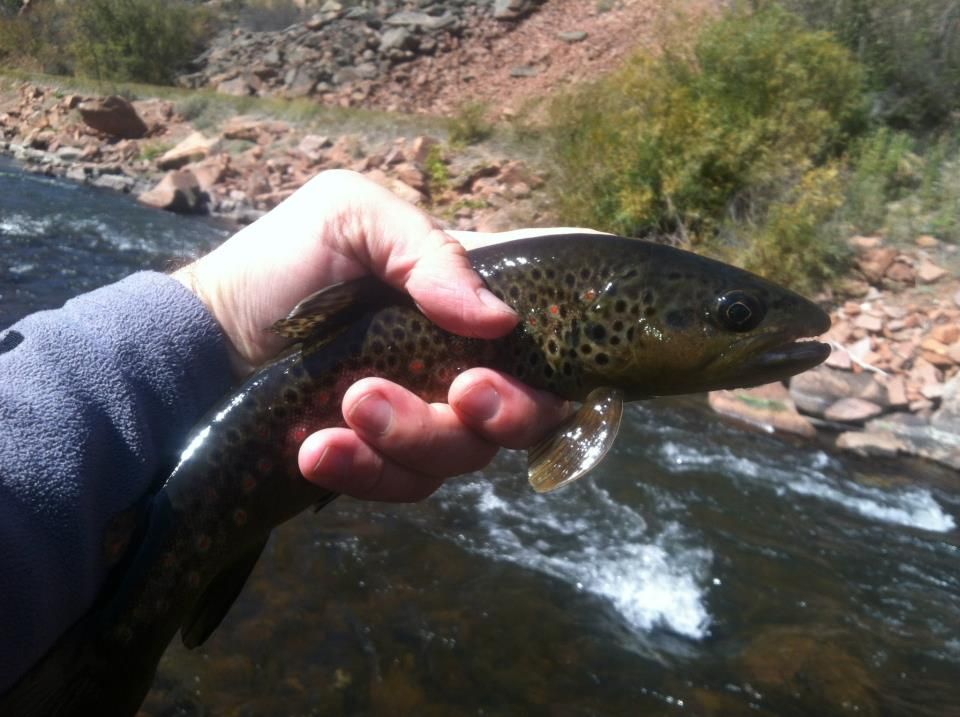
But now that I look at this picture, you can see the remnants of those stripe markings. Cool to actually see these things.
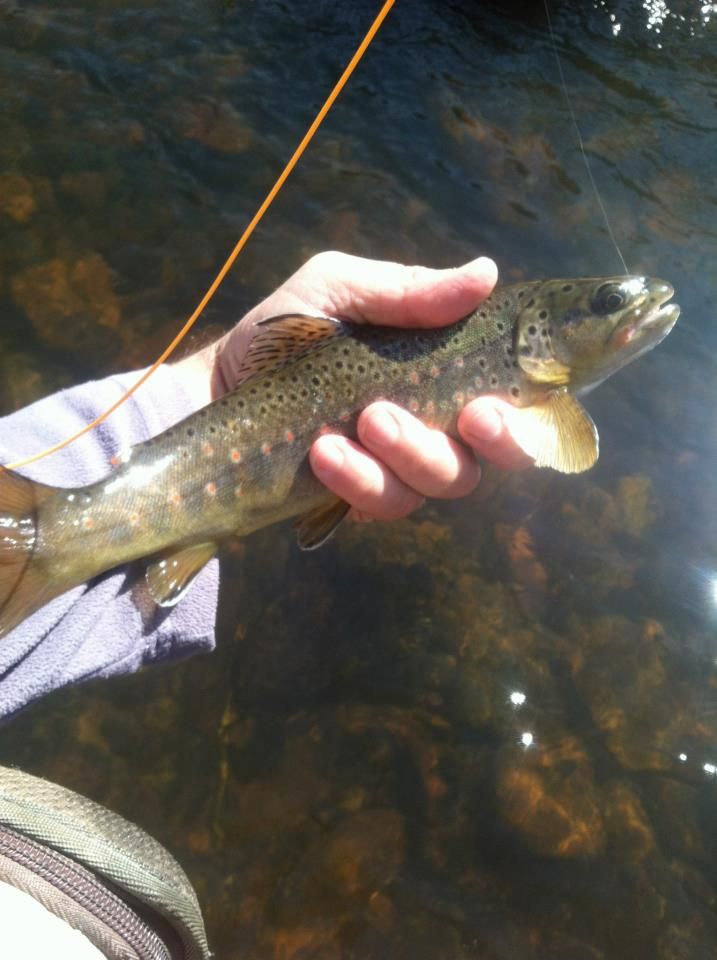
Here's a picture of one, you can't really tell how red they are, but its bright enough that you can see it when they flash under water:

As compared to a normal looking brown caught on the same river:


But now that I look at this picture, you can see the remnants of those stripe markings. Cool to actually see these things.

...but fishermen I have noticed, they don't care if I'm rich or poor, wearing robes or waders, all they care about is the fish, the river, and the game we play. For fishermen, the only virtues are patience, tolerance, and humility. I like this.
DUBBN on Oct 7, 2012October 7th, 2012, 5:15 pm EDT
These two were caught out of the same section of the river back in Mid January.


Have you noticed that all the Browns on the Frying Pan have a red dot on the Adipose fin.
On the Roaring Fork about half the Browns have the spot. The Gunnison and Colorado it is rare to see any Brown have the spot.
I have yet to see a Brown yet that didnt have the Blue spot directly behind the eye. Some are more prominant than others.


Have you noticed that all the Browns on the Frying Pan have a red dot on the Adipose fin.
On the Roaring Fork about half the Browns have the spot. The Gunnison and Colorado it is rare to see any Brown have the spot.
I have yet to see a Brown yet that didnt have the Blue spot directly behind the eye. Some are more prominant than others.
It's OK to disagree with me. I can not force you to be right.
WestCO on Oct 7, 2012October 7th, 2012, 8:20 pm EDT
I hadn't noticed but all my pictures have them too. That's crazy. I'd be very interested to know what that's about. Its honestly a feature that I hadn't noticed and I fish both the Fork and the Pan. I don't get on the Colorado very much, but I'm thinking about starting to fish the sections near Silt more just to save on some gas. Have you fished around there?
...but fishermen I have noticed, they don't care if I'm rich or poor, wearing robes or waders, all they care about is the fish, the river, and the game we play. For fishermen, the only virtues are patience, tolerance, and humility. I like this.
PaulRoberts on Oct 8, 2012October 8th, 2012, 7:57 am EDT
There have been more than two strains introduced, some likely not well recorded. Then they have been mixed in hatcheries and spread all over. Then ... given popns of various mixtures have adapted to local conditions. Then ... there are iridocyte (the pigment cells in fish skin) adjustments to immediate lighting conditions, hormonal/behavioral circumstances, as well as health. Then ... there is individual variation, which can be considerable, as well as mutations. There are common traits shared by most fish of a species or strain within.
Talking about individual variation, here’s a neat one, an almost spotless brown, caught a couple years ago amongst other more “normally” colored/patterned browns:

WestCO, The purple marks distributed along the sides of all salmonids are called "parr marks". They are very prominent in fingerlings and beyond the “parr stage” (less than a year old and named for those markings) into adulthood. Large adults lack them, and likely do so after their first spawn (age 3 on average). Almost all but the very largest/oldest small stream fish tend to have parr marks, and I suspect this is, in part, bc the stress of spawning is too much on top of the normal stresses small waters dish out. Although I haven’t seen studies (except for some brook trout studies), I suspect repeat spawning on many small streams is rare. Productive small waters with good habitat during seasonal extremes likely produce more repeat spawners.
Here's a brown fingerling showing his prominent parr marks:

Interestingly, it also has the red in the tail and ventral fin margins already, but no spot behind the eye yet.
It seems hatchery fish lose parr marks early, as they lose color in general. Browns stocked as yearlings tend to be dull olive and have warped fins.
What the tomato juice-red fins are about I'm not sure but I've seen it a lot, esp back east, but some here too. I cannot associate it with anything but have assumed it’s related to immediate water conditions. I believe I see it most when water conditions are optimum and fish are in prime metabolic space. Possibly certain lighting (clear water but shadowed) plays a role as I seem to associate the two. But both ideas are guesses.
Most browns have that large spot behind the eye, but is most apt to be lost (or mixed in with other large spots) on very large fish.
Talking about individual variation, here’s a neat one, an almost spotless brown, caught a couple years ago amongst other more “normally” colored/patterned browns:

WestCO, The purple marks distributed along the sides of all salmonids are called "parr marks". They are very prominent in fingerlings and beyond the “parr stage” (less than a year old and named for those markings) into adulthood. Large adults lack them, and likely do so after their first spawn (age 3 on average). Almost all but the very largest/oldest small stream fish tend to have parr marks, and I suspect this is, in part, bc the stress of spawning is too much on top of the normal stresses small waters dish out. Although I haven’t seen studies (except for some brook trout studies), I suspect repeat spawning on many small streams is rare. Productive small waters with good habitat during seasonal extremes likely produce more repeat spawners.
Here's a brown fingerling showing his prominent parr marks:

Interestingly, it also has the red in the tail and ventral fin margins already, but no spot behind the eye yet.
It seems hatchery fish lose parr marks early, as they lose color in general. Browns stocked as yearlings tend to be dull olive and have warped fins.
What the tomato juice-red fins are about I'm not sure but I've seen it a lot, esp back east, but some here too. I cannot associate it with anything but have assumed it’s related to immediate water conditions. I believe I see it most when water conditions are optimum and fish are in prime metabolic space. Possibly certain lighting (clear water but shadowed) plays a role as I seem to associate the two. But both ideas are guesses.
Most browns have that large spot behind the eye, but is most apt to be lost (or mixed in with other large spots) on very large fish.
Pryal74 on Oct 8, 2012October 8th, 2012, 9:16 am EDT
Adult wild browns have the blue hue/spot and even sometimes blue streaks behind their eyes and more often then not have some sort of red on their adipose fin.
Also, you mentioned a tiger or a brown hybrid char. These would in fact be the same, being that a Brook Trout is in fact a char.
Also, you mentioned a tiger or a brown hybrid char. These would in fact be the same, being that a Brook Trout is in fact a char.
-James Pryal
Into The Wild Fly Fishing
Into The Wild Fly Fishing
DUBBN on Oct 8, 2012October 8th, 2012, 6:22 pm EDT
Pryal, I am by now way an expert. That being said, I have been looking at the red, or lack there of on the Browns in the different drainages here in Western Colorado. In the 30 years I have been catching the Browns, I have only seen a few in the lower Gunnison that had any sort of red on the adipose. Few on the Colorado in its lower reaches carry the trait. The White River here in Colorado near Meeker, I have never seen the trait. Like I said, I am not trained in fisheries biology, just an amatuer observation.
WestCo, try the Bridge downstream from Silt about a mile. Theres an access to river right, upstream of the bridge. Theres a run of maybe 50 yards that hold alot of fish. If you browse Youtube, you can find some video of it. That being said, the water you are fishing now is better than the lower Colorado. In my opinion.
Dont be scared to use Google Satelite to figure out the access.
WestCo, try the Bridge downstream from Silt about a mile. Theres an access to river right, upstream of the bridge. Theres a run of maybe 50 yards that hold alot of fish. If you browse Youtube, you can find some video of it. That being said, the water you are fishing now is better than the lower Colorado. In my opinion.
Dont be scared to use Google Satelite to figure out the access.
It's OK to disagree with me. I can not force you to be right.
Entoman on Oct 8, 2012October 8th, 2012, 9:45 pm EDT
Well, as far as I'm concerned Dubbn, based on your 30 years experience in the watersheds you mentioned combined with the quality of your contributions to this forum of late, I do consider you an "expert." I also believe the same is true of Jim (Pryal740) who is a professional guide from upper MI, and sees more nice fish in a year than many good anglers see in a lifetime. My sense is there's really no dichotomy created here by differing opinions as this isn't a simple topic with a simplistic answer. It's interesting to read opinions from such disparate parts of the country and I want to thank you guys for the contributions.
I do know that environment has a big influence on this topic and I'll never forget the big dark Brown I took back in the 70's from Putah Creek that had a large red spot in the middle of a bright blue halo smack dab in the middle of its adipose fin. It was one of the most beautiful fish I've seen before or since. To the best of my memory, most of the browns I've caught in my life (and there have been a few) have either had almost indistinct spots or none on the adipose. As to the big blue spot behind the eye, I haven't noticed this character on larger fish that are the ones most remembered, but perhaps that's because its presence or absence is not the most obvious difference separating browns from other species (in spite of the fact I blew it on recognizing Westco's fish. :)).
My understanding is that all our brown trout are descendants from the Scottish strains that were primarily dull colored (with few if any red spots and blue halos) and from the more brightly colored German strain. From a fishing standpoint, I've always felt that a trout is a trout is a trout, in terms of fooling them (with subtle differences and a few givens relative to species). So, I have spent far more time focusing on entomology than ichthyology and thus plead relative ignorance on this topic. I know that fellow Troutnuts like Paul have far more to share on this topic (as he hinted at by mentioning the different strains of brown trout) and look forward to his (and others) further input.:)
I do know that environment has a big influence on this topic and I'll never forget the big dark Brown I took back in the 70's from Putah Creek that had a large red spot in the middle of a bright blue halo smack dab in the middle of its adipose fin. It was one of the most beautiful fish I've seen before or since. To the best of my memory, most of the browns I've caught in my life (and there have been a few) have either had almost indistinct spots or none on the adipose. As to the big blue spot behind the eye, I haven't noticed this character on larger fish that are the ones most remembered, but perhaps that's because its presence or absence is not the most obvious difference separating browns from other species (in spite of the fact I blew it on recognizing Westco's fish. :)).
My understanding is that all our brown trout are descendants from the Scottish strains that were primarily dull colored (with few if any red spots and blue halos) and from the more brightly colored German strain. From a fishing standpoint, I've always felt that a trout is a trout is a trout, in terms of fooling them (with subtle differences and a few givens relative to species). So, I have spent far more time focusing on entomology than ichthyology and thus plead relative ignorance on this topic. I know that fellow Troutnuts like Paul have far more to share on this topic (as he hinted at by mentioning the different strains of brown trout) and look forward to his (and others) further input.:)
"It's not that I find fishing so important, it's just that I find all other endeavors of Man equally unimportant... And not nearly as much fun!" Robert Traver, Anatomy of a Fisherman
PaulRoberts on Oct 9, 2012October 9th, 2012, 8:58 am EDT
I'm not sure I'd call the spot behind the eye "blue", unless we're talking about something different. I'm referring to the large dark (sometimes nearly black) on the cheek directly behind the eye. Some browns have this spot despite lacking any others on the cheek (preoperculum). There's some adaptive reason for this spot, but I don't know what that might be.
The reason I mention the color is because there IS blue on the gill covers of brown trout. It's a turquoise iridescence found on the skin between the spots. This color gets prominent post-spawn. I take it as a sign of recuperation, of health and strength returning. Interestingly, largemouth bass get this color too, especially notable in females in the act of spawning. Going further, an experienced bass observer named Doug Hannon claimed that spawning female largemouths "light up" (almost like excited billfish do but not nearly so intensely) showing a pale blue "aura" in the water. I believe I've seen this too, and in hand such fish have a lot of this turquoise iridescence.
As far as trutta strains stocked here, the known story is of the two original strains, Loch Levan (lake strain) and von Behr (small stream strain). These get all the press. But, there are scattered records of other shipments from Europe, and from the stocking records I've looked at for many fish species, all kinds of things were done and not recorded. Then there are well intentioned/hopeful anglers in the mix. There was a LOT more stocking than most people realize.
Here's a good piece on the original brown trout introductions and what has become of them since. In that section, Chuck Krueger is mentioned. He was my university adviser. This web page has a lot of good brown trout natural history info in it:
http://canadianangling.com/hatchery-river-restoration/
The reason I mention the color is because there IS blue on the gill covers of brown trout. It's a turquoise iridescence found on the skin between the spots. This color gets prominent post-spawn. I take it as a sign of recuperation, of health and strength returning. Interestingly, largemouth bass get this color too, especially notable in females in the act of spawning. Going further, an experienced bass observer named Doug Hannon claimed that spawning female largemouths "light up" (almost like excited billfish do but not nearly so intensely) showing a pale blue "aura" in the water. I believe I've seen this too, and in hand such fish have a lot of this turquoise iridescence.
As far as trutta strains stocked here, the known story is of the two original strains, Loch Levan (lake strain) and von Behr (small stream strain). These get all the press. But, there are scattered records of other shipments from Europe, and from the stocking records I've looked at for many fish species, all kinds of things were done and not recorded. Then there are well intentioned/hopeful anglers in the mix. There was a LOT more stocking than most people realize.
Here's a good piece on the original brown trout introductions and what has become of them since. In that section, Chuck Krueger is mentioned. He was my university adviser. This web page has a lot of good brown trout natural history info in it:
http://canadianangling.com/hatchery-river-restoration/
DUBBN on Oct 9, 2012October 9th, 2012, 11:21 am EDT
It's OK to disagree with me. I can not force you to be right.
PaulRoberts on Oct 9, 2012October 9th, 2012, 12:27 pm EDT
I see. I was never aware that the spot is often blue. I looked at a bunch of images I have and all have the "blue/purple" spot but they vary quite a lot in how deeply pigmented they are. I'd never noticed the pale ones before as a lighter version of the same spot. Thanks DUBBN.
Pryal74 on Oct 10, 2012October 10th, 2012, 11:34 am EDT
I was in no means trying to sound like an expert or to start an argument. Just as Entoman says, an observation. If I get time later I can show you, it can be found on lake-run as well as river res fish here. I am certain it can be found on browns almost everywhere.
-James Pryal
Into The Wild Fly Fishing
Into The Wild Fly Fishing
Quick Reply
Related Discussions
Topic
Replies
Last Reply





